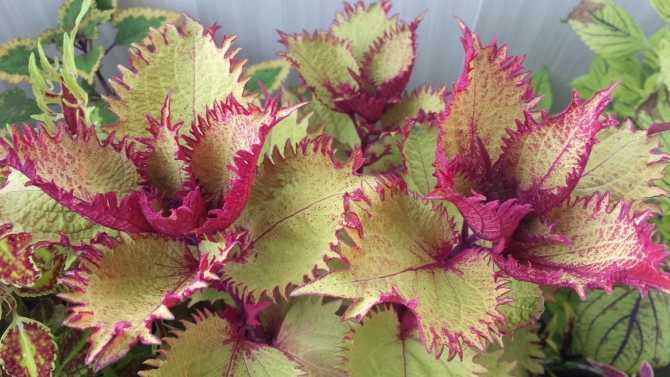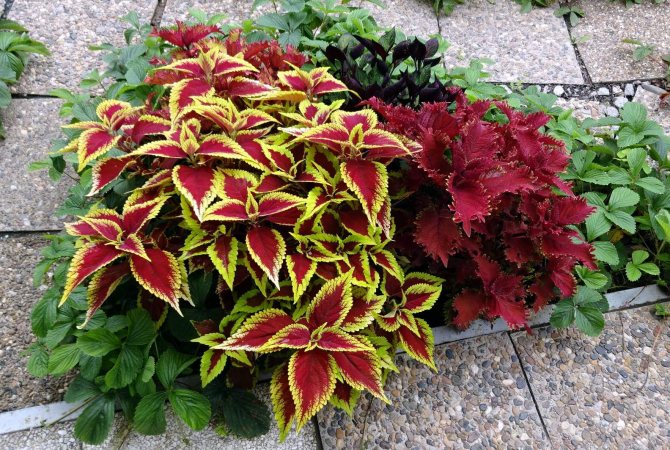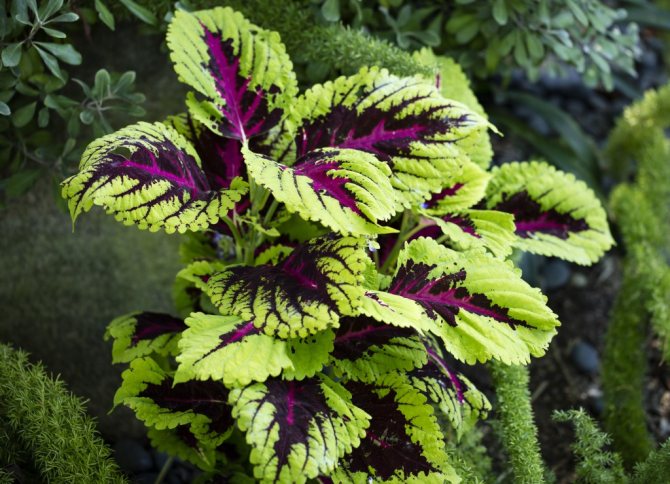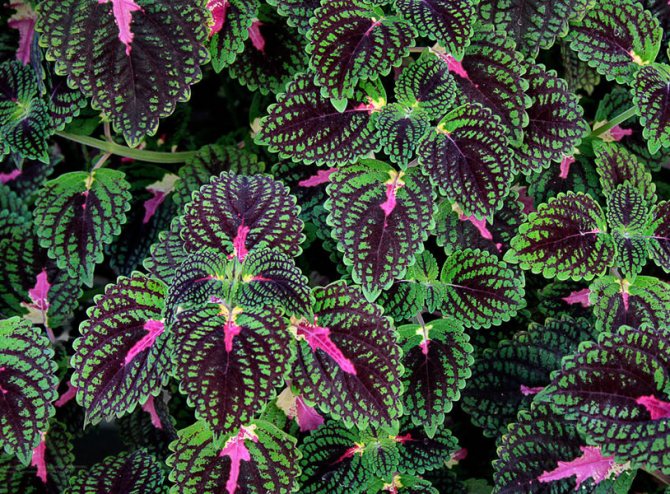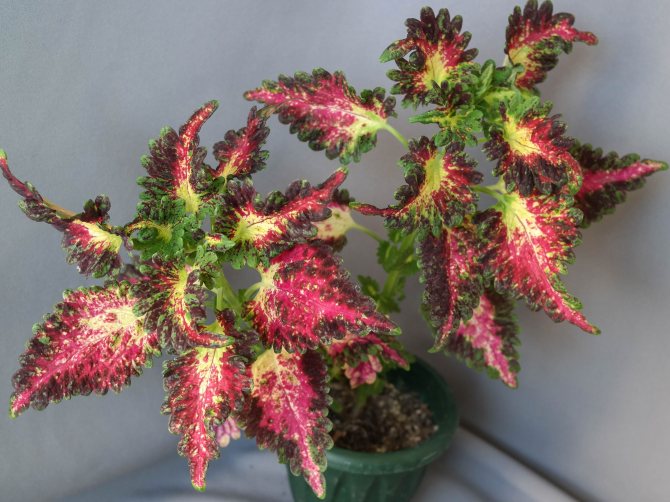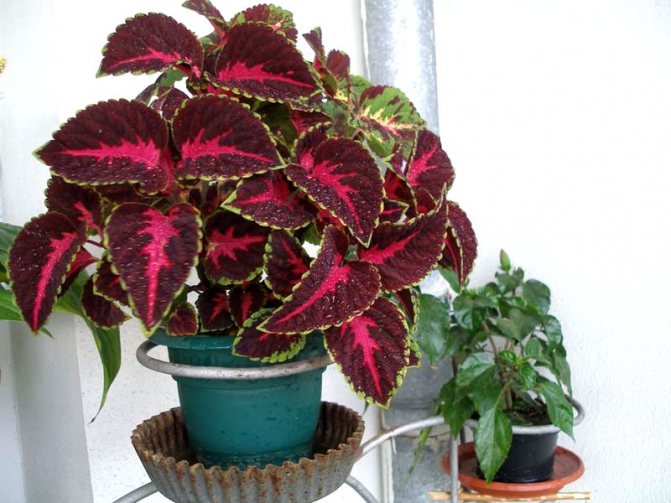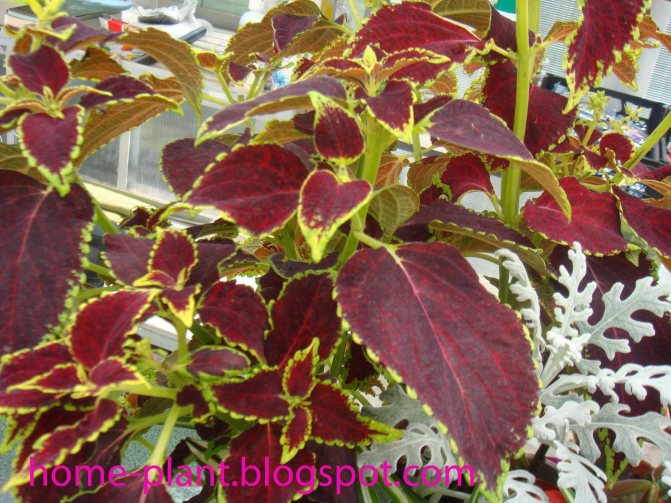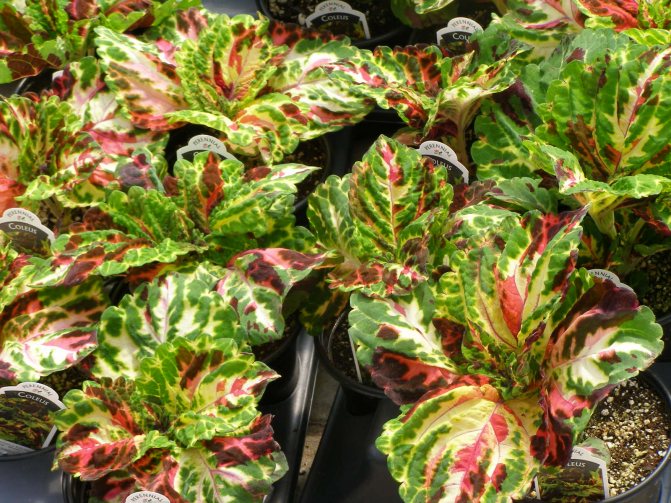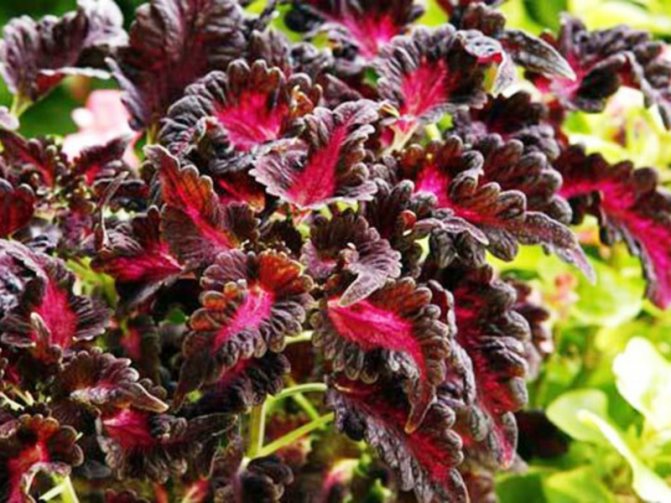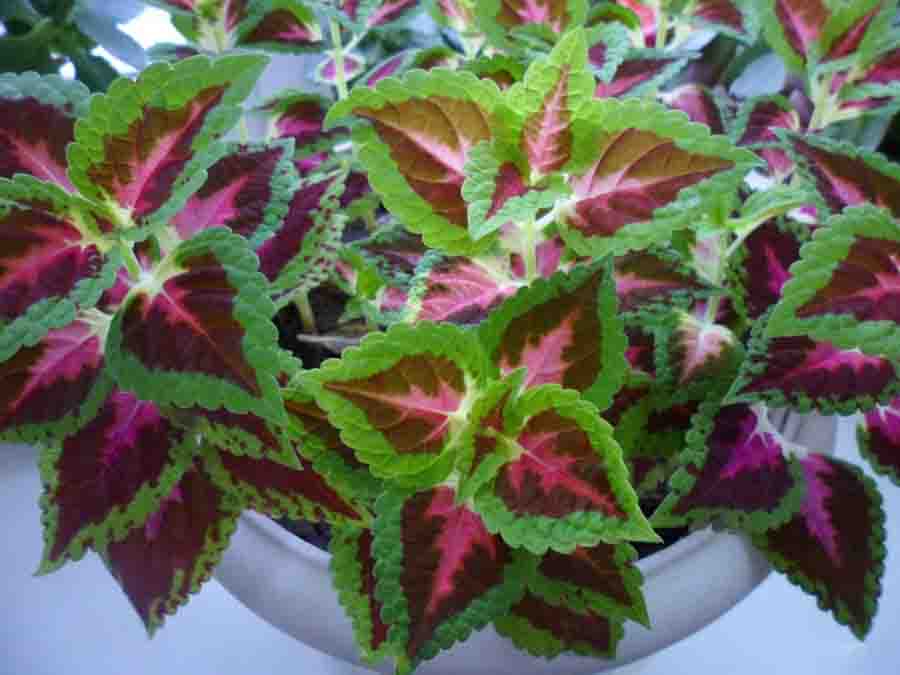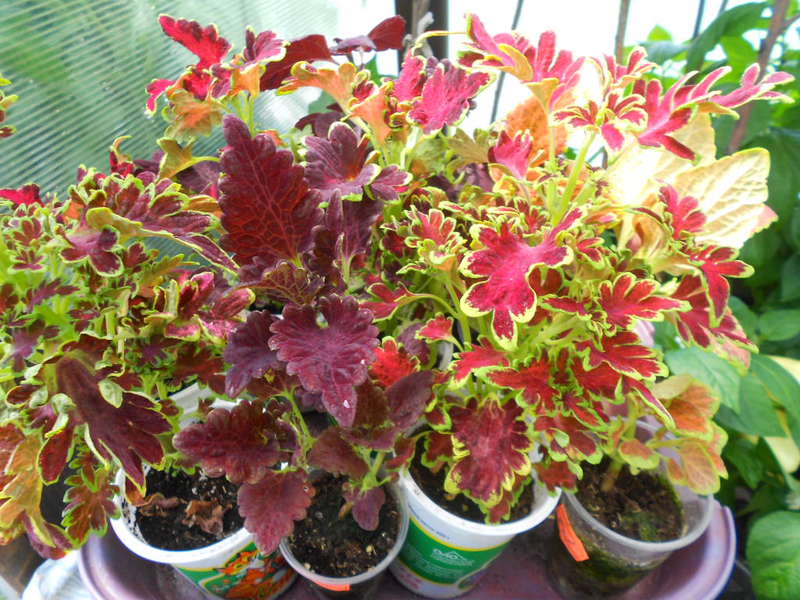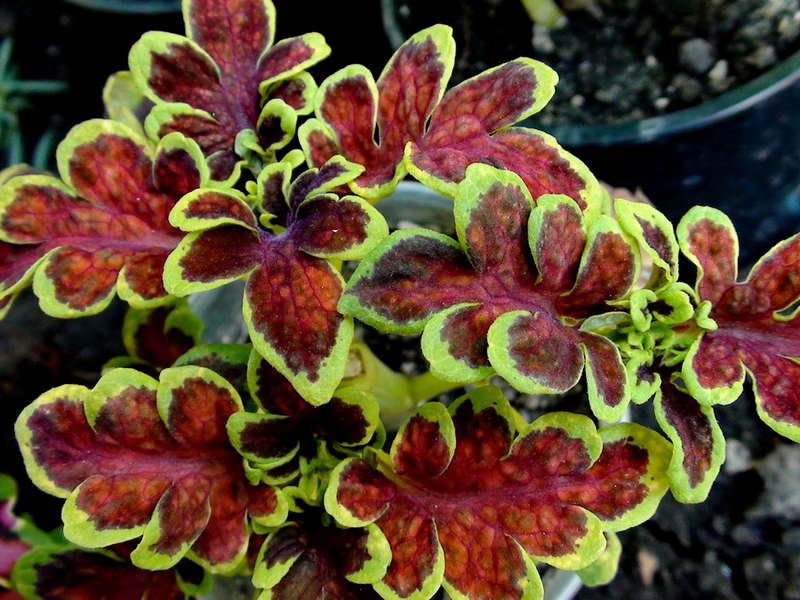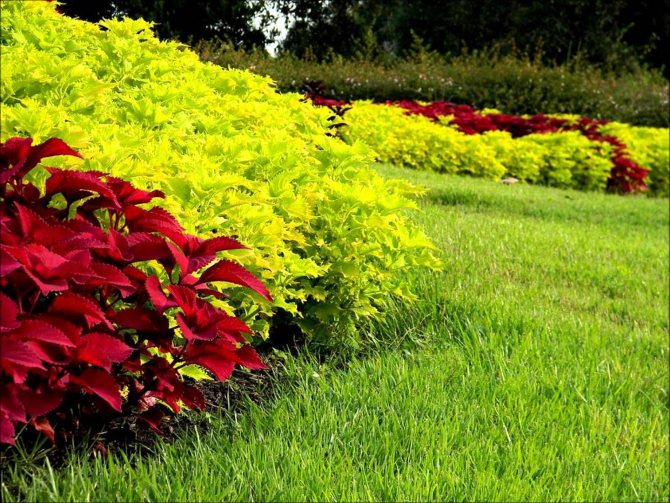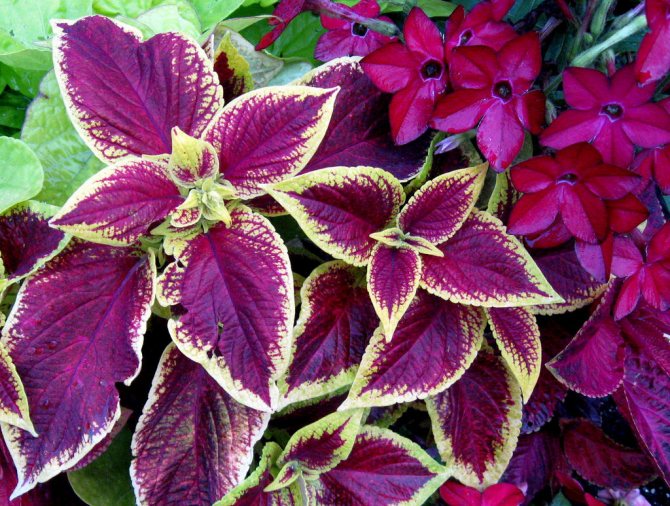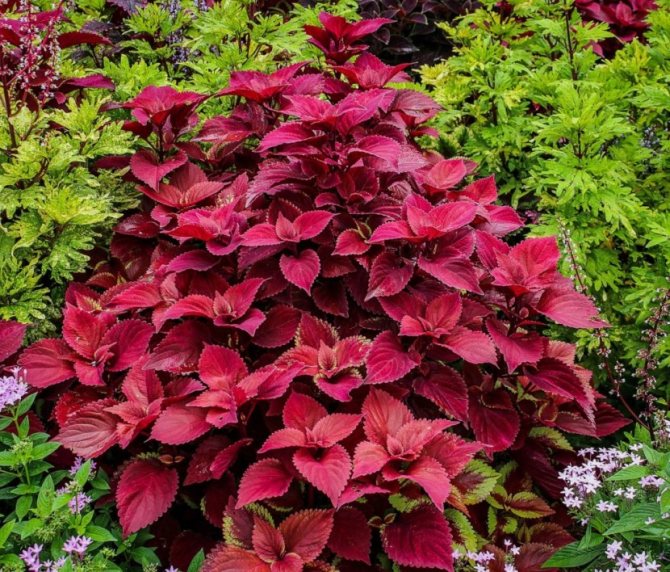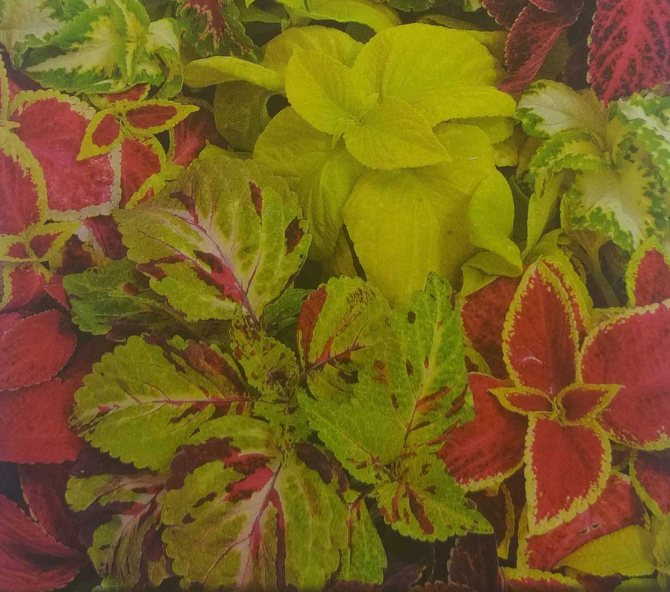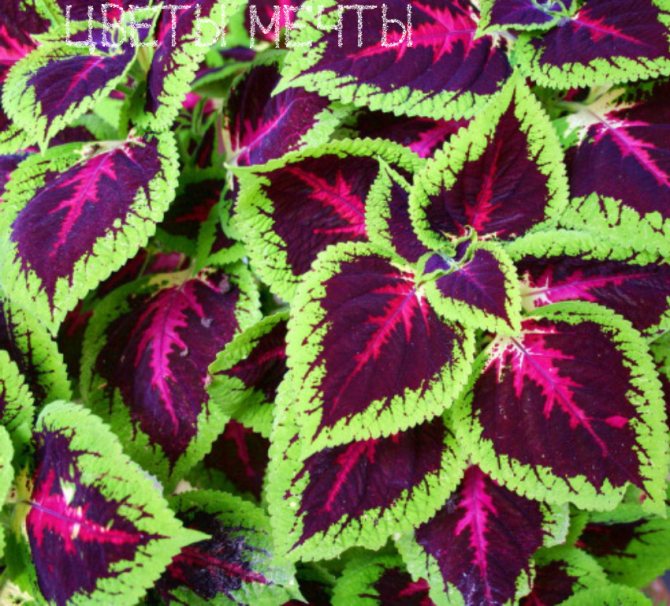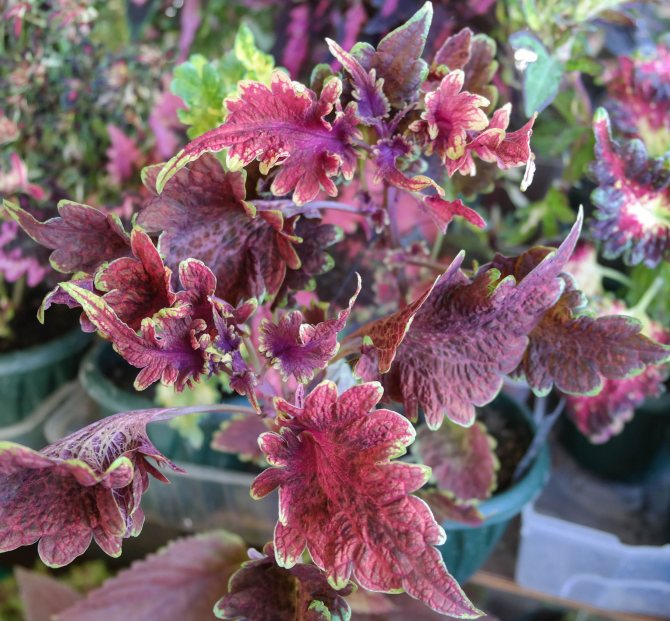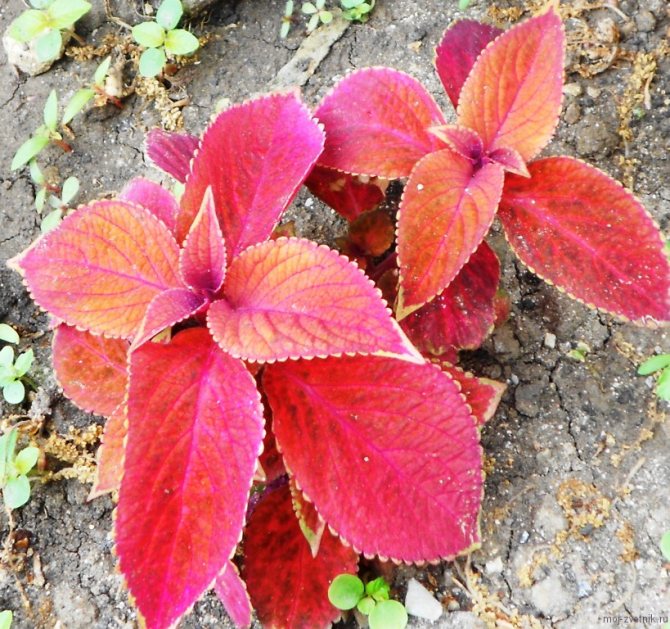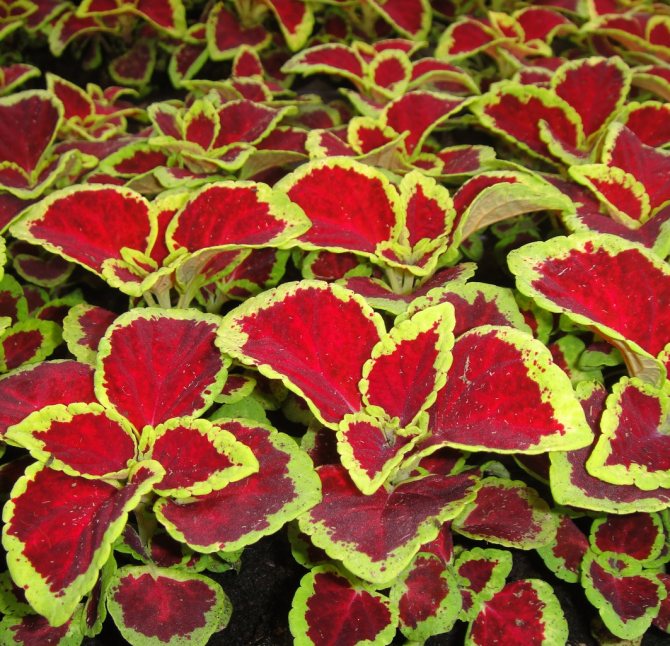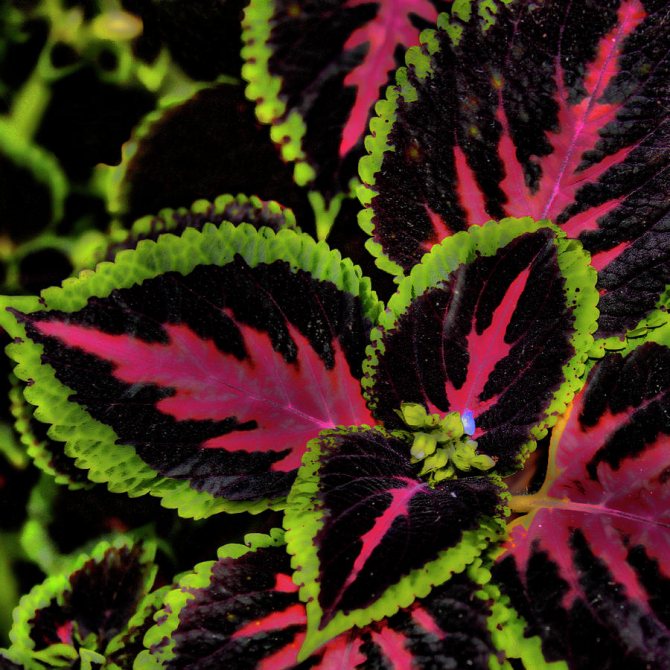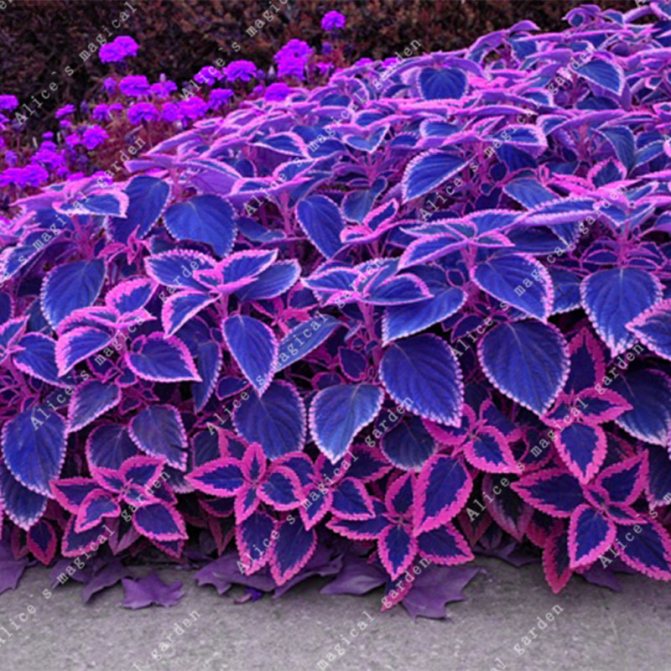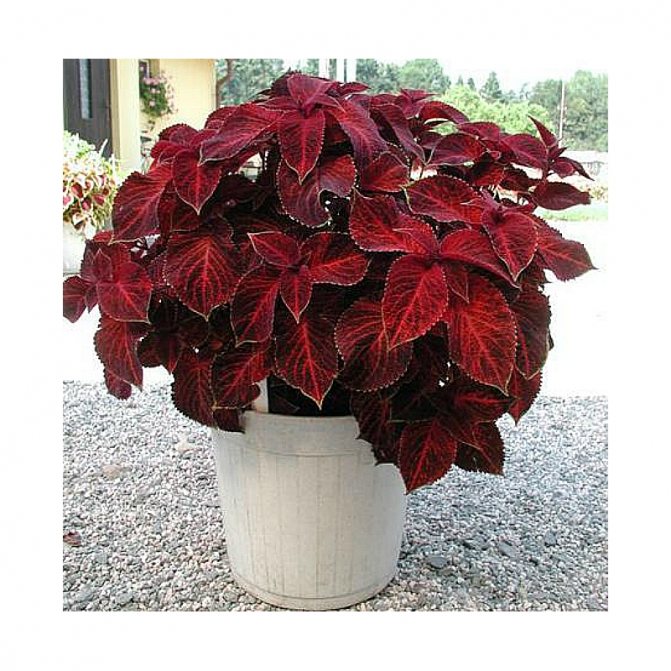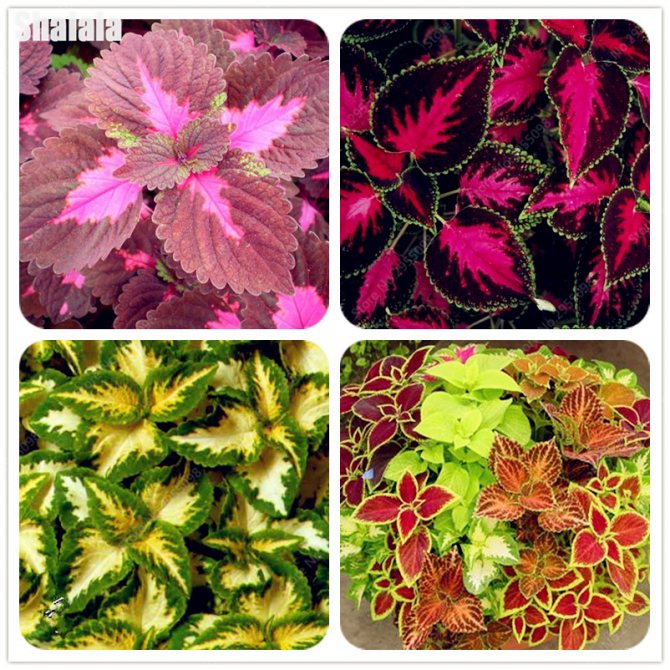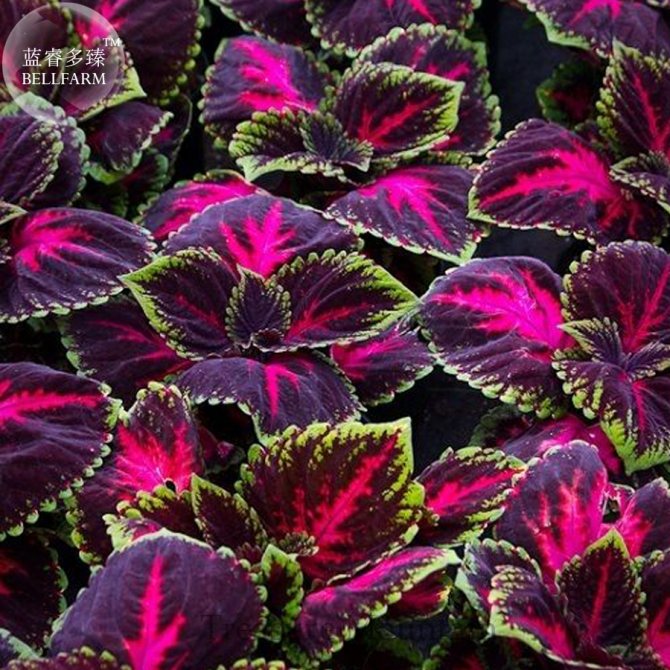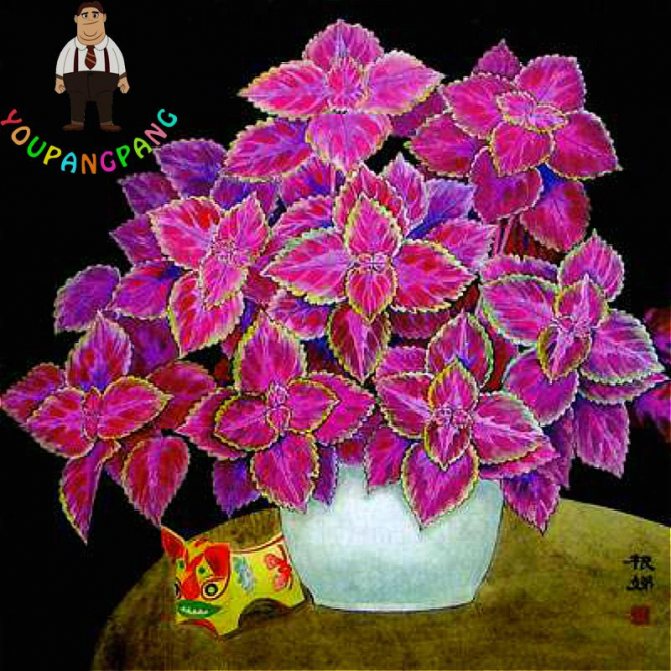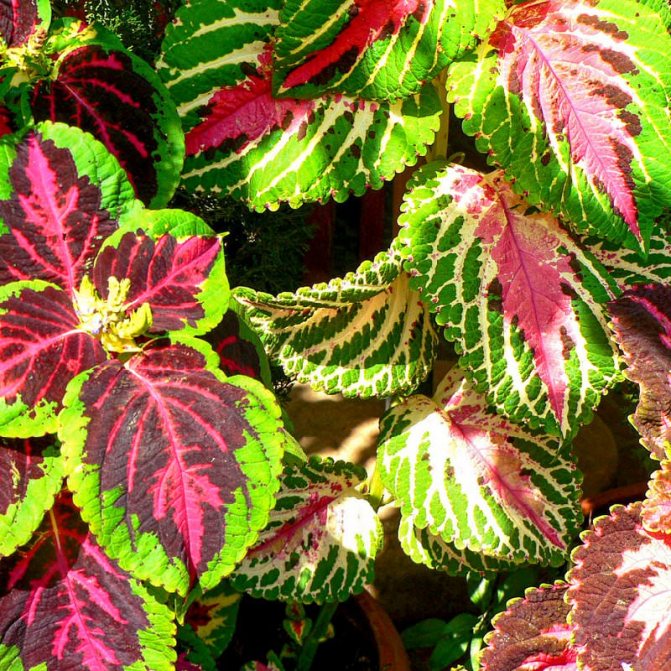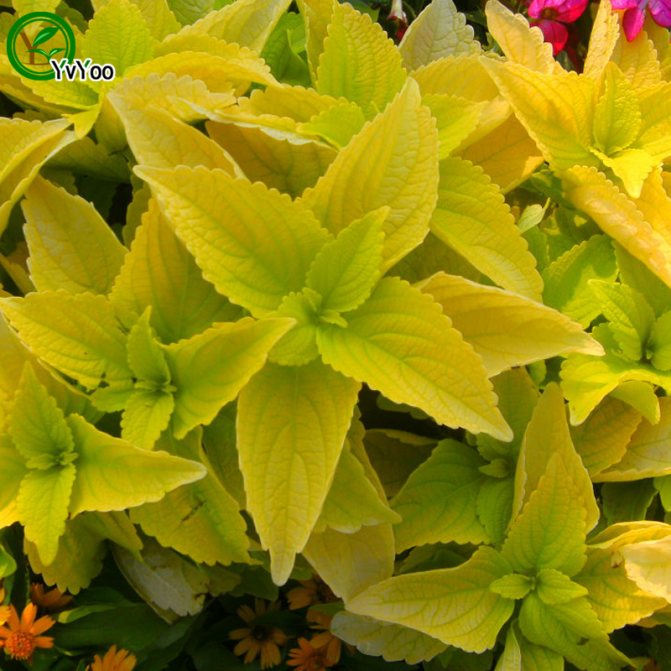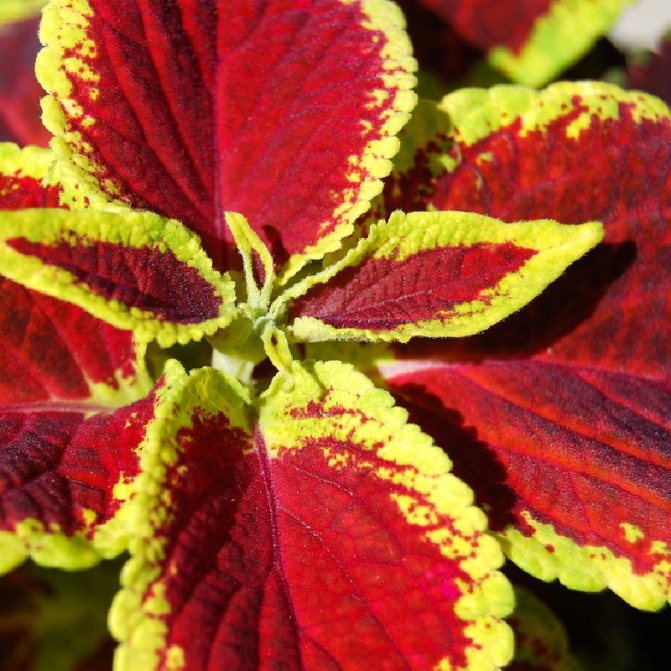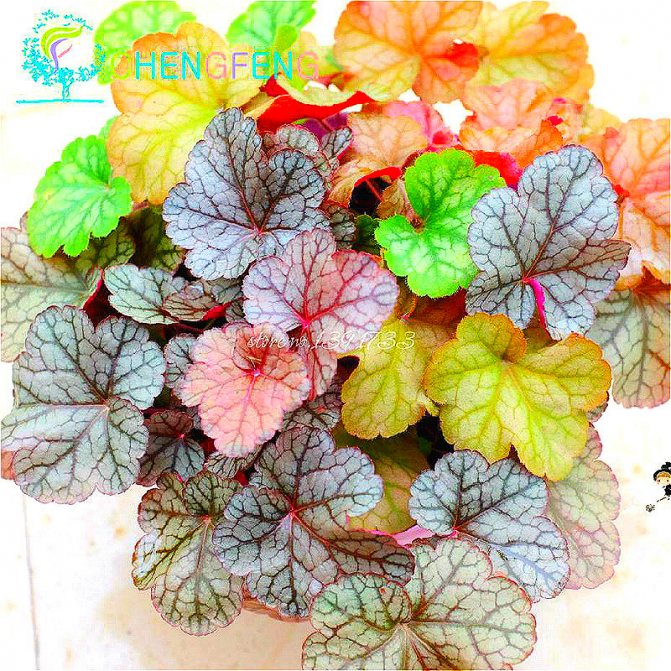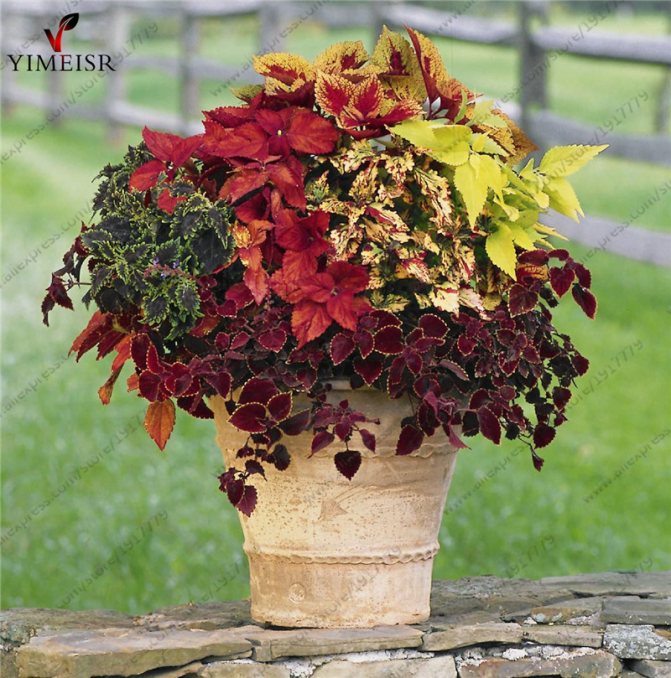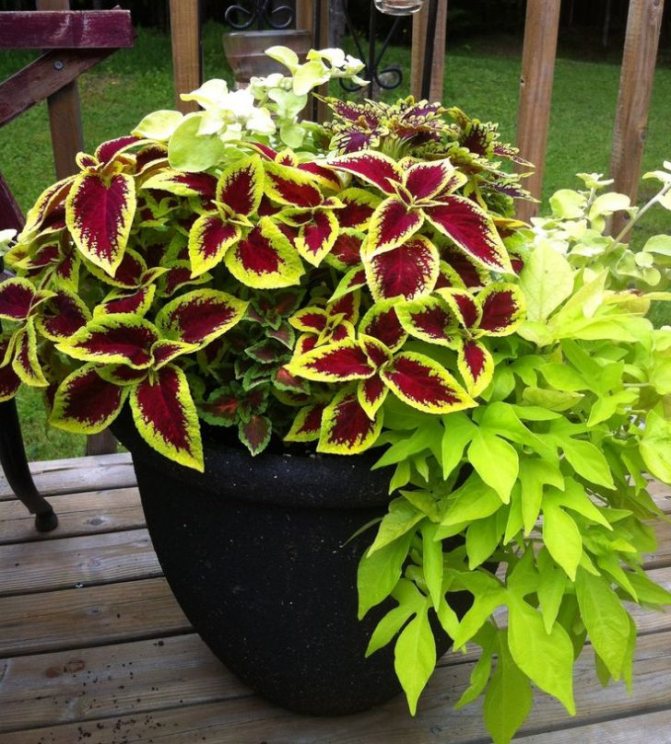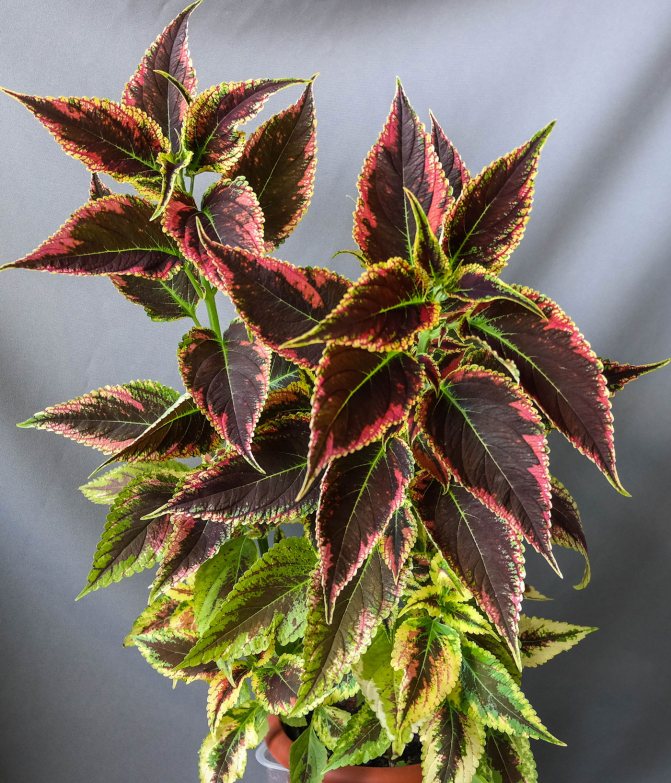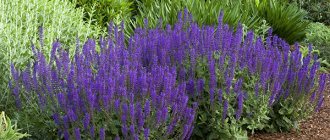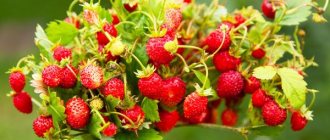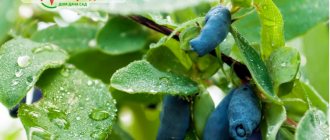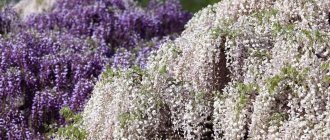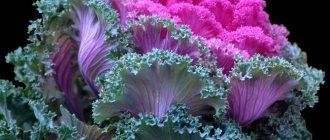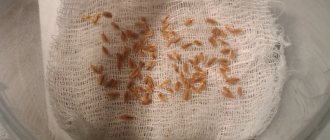The herbaceous ornamental plant Coleus from the Yasnotokovye family, rooted in the tropical regions of Asia and Africa, has spread as an ornamental culture. Its presence in a flower garden, on a bed and a lawn has a beneficial effect on their appearance - it is so beautiful in single and group plantings, shading the usual greenery of other plants. Herbaceous bushes simply play with a rainbow of colors, enlivening any corner of the garden or local area. Planting and caring for Coleus does not cause difficulties even for novice florists.
Coleus: flower description
Coleus leaves have an oval shape that resembles an egg. The edges are serrated, there are varieties with wavy, fringed, curly edges and a wide variety of colors. Leaves of varieties that are decorative, grow up to 15 cm. Stems are tetrahedral.
Most of the Coleus resembles nettle in appearance, for which they received the popular name - nettle.
The flowers are collected in paniculate inflorescences, have white, bluish and yellowish shades. The pistil at the base is closed with stamens, which grow together into a tube: hence the "coleus": translated as "case".
Varieties of Coleus
There are about 150 types of culture known in the world. In regions with a warm climate, this plant is perennial, and in regions with cold winters, it is an annual or indoor plant.
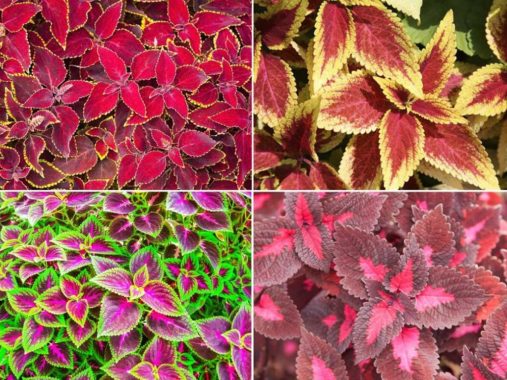
The most common types:
- Coleus hybrid (Coleus hybridus) is a herbaceous perennial with a high (50-80cm) erect stem. Leaves are wide, oval-heart-shaped, uniform or variegated in color. Planting and caring for hybrid varieties does not differ from the same activities with simple species.
- Coleus Blume grows up to 80cm, most often grown in temperate regions. Large, in the form of a pointed egg, the leaves have a varied palette of colors. Small purple flowers are collected in a nondescript spikelet. Among the varieties of this species there is a dwarf (15 cm) with cherry-pink leaves and a yellow-green border - K Saber.
- Coleus Renelta is a decorative ampelous species with a wide variety of colors. It is used for decoration of premises, balconies, gazebos.
Coleus landing
Coleus are grown both at home and in flower beds, on balconies and loggias.
Planting methods
If coleuses grown from seeds are planned to be placed in the garden, then they are hardened before that: they begin to take them outside during the day, when at this time of the day the temperature starts to hold at 10-15 degrees. This is also the case with coleus grown from cuttings. In the flowerbed, a distance of 10 to 15 cm is left between the seedlings, depending on the variety.
If the coleus are grown for boxes on the balcony or loggia, then they are planted there in 10 cm increments. If the coleus are different in color, then a planting system is developed to achieve maximum decorativeness.
Coleus grown in rooms are planted in small pots. In order to achieve greater bushiness in a short time, to make it easier to form a bush, several plants are planted in one pots at once, both of the same color of leaves, and different ones.
Optimal planting time
Coleus plants are tropical, so they do not tolerate the slightest cold snap.You can plant them in open ground only when the nights become warm enough, usually in early June.
Boxes with coleus on the balcony can be put out already at the beginning of May, if warm days have come, but they are brought into the house at night.
Indoor coleus are planted in pots as soon as they reach 15 m in height when propagated by seeds or take root during vegetative propagation. This is done in March or early April and, as a result, they have a beautiful plant in the summer.
In a pot intended for planting, good drainage is arranged: coleus like abundant watering, but do not tolerate stagnation of liquid.
Soil for planting
There are no special recommendations for the composition of the soil for this flower. But do not take the poor and heavy. It is better to grow the plant in sod or leafy ground, and a light garden one will do. You can pour humus into the pot, which will help build up the leaf mass.
It is ideal to plant in a mixture of equal parts of sand, peat, humus and turf or leafy soil.
Coleus features
Coleus are perennial and annual grasses or shrubs. The peculiarity of the plant is ribbed stems with four faces and broadly oval, with denticles along the edge, leaves with ornaments of different colors. The color of the leaf plate and the ornament is different for each species, it can change depending on the lighting. The color combination is quite unusual and gives the plant a bright unusual color. Due to the shape of the leaf, similar to the nettle leaf, coleus is colloquially called "nettle".
Planting coleuses of different colors and with different leaf sizes, they give the plantings an original bright look - the rapidly growing bushes will not leave anyone indifferent.
Features of flower care at home
Although caring for Coleus is considered easy, there are still some subtleties and nuances that should be known and taken into account.
Location and lighting for the plant
This flower loves light and sun. In poor light, it begins to stretch out and throw off the leaves. But with an excess of sun, it stops growing and loses the brightness of the leaves.
To place it, they choose bright, but slightly shaded places in the garden and keep it on the eastern or western window sills in the room. It is recommended to turn the pot sometimes so that the bush is even. You should also know that green coleus requires less sun than specimens with variegated leaves.
Air humidity
Like all people from the tropics, Coleus do not tolerate dry air. But with frequent spraying, they grow well in the room.
Temperature regime
Coleus do not like temperature changes. They grow successfully at 20-24 degrees.
How to water properly
Coleus loves moisture. It should be watered with warm soft water, in summer the soil should always be wet, in winter you can wait for the top layer of the earthen coma to dry out before watering. Coleus loves frequent spraying and warm showers. In the garden, it is watered from a watering can with a fine strainer so that water is constantly on the leaves. This watering is done only in the evening.
Fertilizing and fertilizing a flower
Plants planted in a sufficiently fertile soil in the garden do not require feeding, but they respond gratefully to watering with a mineral fertilizer with a high potassium content. It is useful to water coleus both growing on the street and in the room with nettle infusion.
A home flower is fed weekly with complex fertilizers in summer, and less often in winter, twice a month, and the nutrient solution is made twice as weak. This helps the plants not to stretch.
Planting care
For Coleus, the soil must be kept moist, preventing it from drying out, but it cannot be poured, otherwise the roots will begin to rot, i.e. watered moderately and frequently.


To give splendor and brightness in the summer, the bushes need to be fed with fertilizers for ornamental crops once every 10 days.The point is important - there should be a minimum amount of nitrogen in fertilizers, since it affects the color saturation. When growing in an apartment, fertilizing with mineral fertilizers in winter is carried out only in case of insufficient lighting.
Pruning
A bush in the form of a fluffy ball will turn out if you remove the apical bud and buds on the side branches with a bush height of 4-5 cm and the length of side branches up to 5 cm. This procedure is carried out with bushes of any age. To obtain a tall, straight bush, the side branches are cut off.
The bush grows well when the inflorescences and tops of the shoots are removed by 1-2 cm - the plant does not spend energy on flowering. It should be noted that the culture tolerates pruning well and it is possible to form a bush of the desired size and shape throughout the entire growth period.
Care features
You do not need to cut off all the inflorescences and leave a few to add variety to the flower garden - spikelets of small flowers look beautiful among low-growing plantings.
Coleus quickly reacts to lighting, turning the leaves and stems in the wake of the sun, so at home, the pot needs to be unfolded periodically so that the crown does not form one-sided. In the flower bed, the desired direction is given with the help of a peg.
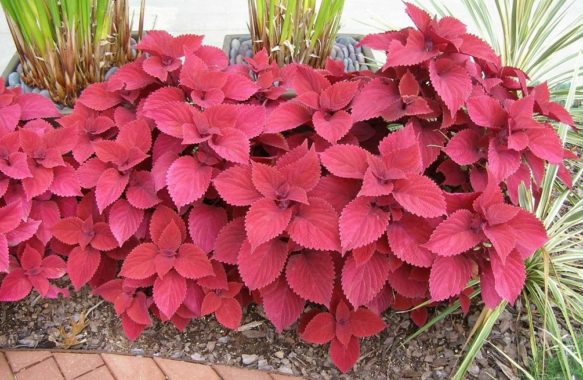

If the garden coleus is planted as a perennial, with the onset of cold weather, the bush is brought home, choosing a well-lit place, and care is taken as a houseplant. If there is a lack of lighting, perform additional illumination. In the spring, in March, it is imperative to perform rejuvenation to activate the growth of young shoots - to cut off the old leaves and the tops of the branches. With the onset of warmth, the flowers are again taken out into the street.
Advice! You should not bring old bushes home, it is better to take cuttings from them and plant a new plant.
Coleus pruning
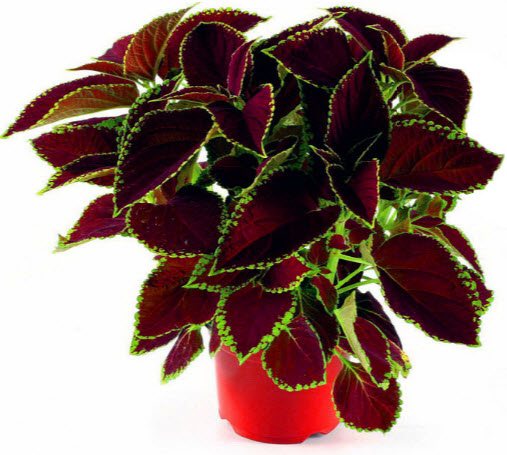

Coleuses need regular pruning for various reasons:
- in order to stop growth: such pruning is done as the plant grows, as soon as it reaches the desired size, it is pruned, thus forcing it not to grow in height, but to actively increase the green mass;
- two to three weeks after picking for more tillering;
- to form a bush: coleus can easily be given the required shape, but pruning for this purpose is carried out when the plant is lush enough;
- seasonal pruning: produced in the spring of overwintered Coleus, since due to a lack of light, most of them stretch out and lose their decorative effect, cut off cardinally, leaving two or three buds on the trunk;
- for the purpose of cuttings for planting: young shoots are not suitable for this, old ones are cut out, it is better to collect those located closer to the crown.
Types of coleus: photo
Coleus transplant
Coleus do not require frequent transplantation, their root system does not differ in power.
Transplant methods
Most often, Coleus is grown as an annual crop, so it does not come to transplanting. But if the flower is preserved in winter, then in the spring it should be transplanted into a larger pot, because the roots are already getting cramped, it is impossible to achieve intensive growth. Coleus easily tolerates a transplant; it should be done after the seasonal pruning of the plant.
The plant is also trans-shipped. If the flower pot is large enough, but the plant has been in it for more than a year, it is necessary to renew the soil. Coleus is removed, the roots are lightly shaken off and placed in a pot of the same size, but all the empty space is filled with new soil.
Seed method of growing Coleus
The purchase of seed material will not cause difficulties - the stores offer a large selection of varieties for every taste. Sowing Coleus seeds for seedlings can be started in mid or late March, having taken care of the containers in advance: plastic cups with drainage holes, small cassettes, peat cups. Peat tablets are also a great option.
Information! Seeds from Holland and England have the best germination.
The soil can be used purchased or prepared independently by mixing black soil, crushed needles, cow dung, river sand in a ratio of 4: 2: 2: 1. Sand and black soil should be sieved and heated in the oven.
You do not need to bury the seeds in the soil - they are scattered over the surface, lightly pressed with a spoon, sprinkled with sand and moistened with a spray bottle. The container is covered with a transparent material (glass, film) and placed in a warm (20 ° -24 ° C) place. After germination, the shelter must be removed. When the seedlings get stronger, rearrange them in a cooler place with a temperature of 16 ° -19 ° C and with good lighting, but direct sunlight must be excluded to avoid burns.
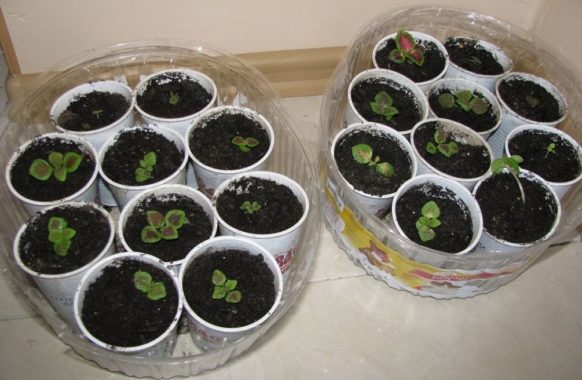

Picking into cassettes for root development is carried out when 2 true leaves appear. It is possible to transplant into individual containers, for example, 0.5 liter cups, with 3-4 leaves, pinching the top.
Planting Coleus seedlings in open ground in a previously prepared place is carried out when the soil warms up.
Reference! If it is not possible or did not have time to sow a change for seedlings, you can sow them directly on a flower bed, in a flower garden, and sow seeds of other flower crops nearby.
Reproduction of Coleus


Coleus reproduce so easily that many growers prefer to leave one or two plants for the winter for the purpose of vegetative propagation, and sometimes they throw everything away with the onset of autumn and in the spring they get new plants from seeds.
Reproduction methods
Seed propagation is the easiest way. Seeds of even rare varieties have almost one hundred percent germination.
First, prepare the substrate for sowing, usually peat mixed with sand. The substrate is laid out in shallow bowls, moistened and the seeds are sown. Considering that almost all of them will sprout, the seeds are laid out at some distance from each other, it is enough to do this with a step of 2-3 mm. They are sprinkled with a thin layer of soil and sprayed from a spray bottle.
You can cover the dish with glass or put it in a plastic bag. Further care will consist in watering, and if the bowl is covered, then also in airing. Seeds sprout almost simultaneously in 10-12 days.
At first, shoots of any variety will be green. The coloration appears later. A container with young shoots is placed on a light windowsill, it is desirable that there are no drafts, and the temperature does not drop below 20 degrees.
Seedlings grow quickly, and it is important not to hesitate with a pick, otherwise the plants will stretch out. Therefore, after the appearance of two or three leaves, they are dived in increments of at least 3-4 cm. The seedlings tolerate this procedure easily. When the plants grow up to 15-20 cm, they are planted in a permanent place.
Propagation by cuttings carried out both in the fall when the plant is provided with good lighting, and at the end of winter, in order to have a full-fledged plant by the spring. Cut the cuttings, put them in water. Roots appear quickly. Can be dissolved in water and phytohormones. Coleus is planted in the ground after the roots appear.
Reproduction by sheets is not common.
Use in landscape design
Nettles have extremely unsightly varieties. Therefore, the most beautiful varieties with bright colors of leaves are used for flower beds.
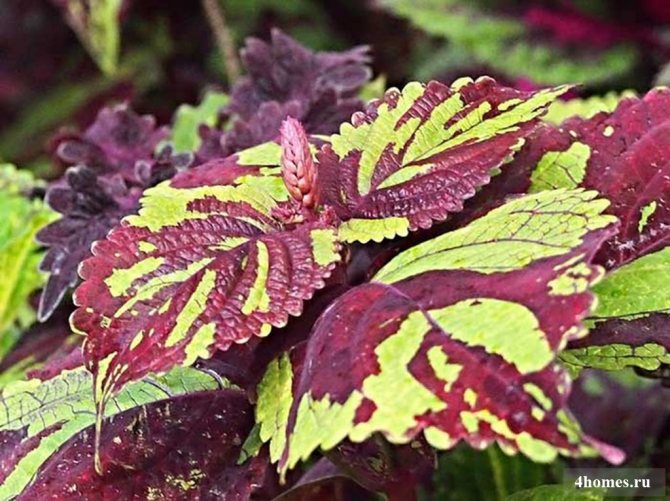

Sometimes the flower bed lacks brightness. Coleus will correct the situation when the dominant plants have not yet bloomed or have already faded. The lawn with cheerful islets of nettles is very effective.


Coleus is universal. It goes well with conifers, annuals and perennials. Will accompany ageratum, verbena, cuffs, irises, daylilies, chamomile, ivy, etc. Nettles, planted in a row, look beautiful as a border decoration.


If you plant different varieties of nettles in the form of different geometric shapes, you get vivid pictures!
You can not transplant indoor specimens into a flower garden, but leave them in pots.But they will have to be watered often, on hot days even 2 times a day, since the container, not buried in the ground, heats up quickly.


As you can see, Coleus will not give much trouble. It grows quickly and is ideal for busy growers. It can be safely grown in the country, even if it is not possible to go to it every week. Simple propagation methods make it possible to create beautiful flower beds with a minimum investment.
Problems, diseases, pests
Coleus suffer from aphids, spider mites, scale insects and whiteflies. Coleus home is more vulnerable than outdoor. For the prevention of parasite damage, it is necessary to examine the flower more often and wash it under the shower.
Insects are found on the back of the leaves. A signal that the Coleus is possibly infected is discoloration and deformation of the leaves. For treatment, it is necessary to cut out the affected parts of the flower and treat the plant with an insecticide.
The main cultivation and disease problems are associated with defects in care:
- decay of the lower part of the stem: stagnant moisture due to lack of drainage;
- the ends of the leaves become brown: dry air, little watering;
- leaves fall off the coleus: low temperature, drafts;
- light spots are visible on the leaves: direct sunlight;
- leaves lose brightness: lack of lighting;
- coleus slows down growth: too poor soil.
Choosing a landing site
If you are going to acquire a Coleus at your summer cottage, the first thing to do is to choose the right place for planting it. This plant prefers a well-lit area, where, under the influence of sunlight, the color of the flower leaves will become as bright as possible.
However, here it is necessary to remember some rules. For example, varieties with red or white leaves tolerate direct sunlight well, while varieties with green leaves (any shade) respond much worse to bright light.
Because of this, during periods of increased solar activity, they need to be shaded, although it will be more practical to immediately land in partial shade. If this is not done, burns will appear on the leaves, and the flower will lose all attractiveness.
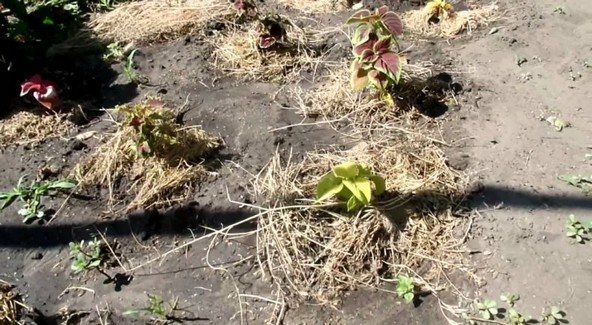

Popular species (varieties)


To date, more than 100 varieties of Coleus are known in indoor floriculture.
There are bush and ampelous forms, dwarf varieties, however, the latter are still rare. The most popular types:
- Dark Chocolate: leaves are dark brown;
- Black Dragon: almost black leaves with strongly fringed edges;
- Fantasy: the leaves are of many colors and shades, they are strongly twisted, cut almost in half;
- Velvet of the night: dark red-brown leaves with heavily jagged edges;
- Jade Wizard: leaves of two-contrast colors: bright green and bright yellow.
- Blume: variety with a huge variety of leaf colors;
- Vershaffelt: this coleus has the largest leaves;
- Pomilus: dwarf form of a coleus;
- Coleus Scarlet: it has an intense, mostly monochrome color;
- Coleus Henna: interesting coloring, green with specks;
- Coleus Wizard: has velvet leaves with a different color.
General acquaintance
This herbaceous plant belongs to the Lamiaceae family. Coleus is a decorative deciduous representative of the flora. Its stems are thin, and the velvety leaves can be colored in various combinations of green, yellow, burgundy, brown and red. Color areas amaze with a variety of combinations - these are stripes, spots, streaks, streaks, etc. 2-4 colors can be combined on one leaf! Adult specimens form compact clumps 30-35 cm high, but there are also tall varieties.
The shape of the leaves is cordate, the edges are serrated, in some varieties they are wavy. It is similar to the shape of nettle leaves, which is why growers fondly call this plant nettle. Coleus blooms with white, blue or purple flowers. Complex spike-shaped inflorescences are not decorative.They need to be cut off in time so that the plant does not lose its neat appearance.


Useful Tips
- As a rule, the leaves of Coleus have a bright variegated color, so that it plays with all the colors, it is necessary that the leaves of neighbors on the windowsill or flowerbed are monochrome. In the garden, it looks great in the neighborhood with gray fescue and cineraria.
- In winter, Coleus should be placed on the kitchen windowsill.
- In order to calculate the planting time of Coleus, you need to know that the plant acquires a rather decorative appearance 5 months after planting.
- If the flower is dried, it has lost tugor (the leaves have become soft), then it is necessary to water it abundantly and spray. The plant will quickly return to its former form.
- The higher the temperature, the more watering.
- It is better to plant small-leaved coleus in the garden: they grow faster and cover the entire allotted space.
Pest and disease control measures
If the watering norms are violated, the roots of the plant can be affected by rot, the leaves will begin to fall off. You should periodically inspect the bushes and, if there are signs of a disease, take action by treating them with special preparations.
Of the pests, Coleus is liked by mealybugs, aphids, whiteflies, spider mites. At the very beginning, until the pest has managed to hit the plant strongly, you can use simple home remedies, at later stages apply insecticidal agents, for example, Bison, Aktofit, Confidor Extra.
Folk remedies for pest control:
- Mealybug. Treatment of the affected areas with alcohol (moisten a cotton swab) or spraying with daily infusion of lemon and orange peel (50 g per 1 liter of boiling water) will help.
- Whitefly. Pour crushed soap (household, tar) with water (1: 6), beat with a sponge and apply foam to the place of the colony, you can spray the entire bush and water the soil around.
- Aphid. Spraying with a solution of laundry soap (300g per 10l) or tar (100-150g per 10l) with the addition of ash. The effect is enhanced if the agent is heated for half an hour. Ash can be used to pollinate the soil near the plant.
- Spider mite. A good result is obtained by treatment with soapy water, ammonia solution (30g per 10l), daily infusion of garlic (30-50g per 10l boiling water).
Coleus, planted on the balcony, in the country house will delight with a bright motley color throughout the season, and planted in an apartment will create a summer mood, bringing home a sunny smile and, at the same time, growing and leaving will not bring much trouble.
Answers on questions
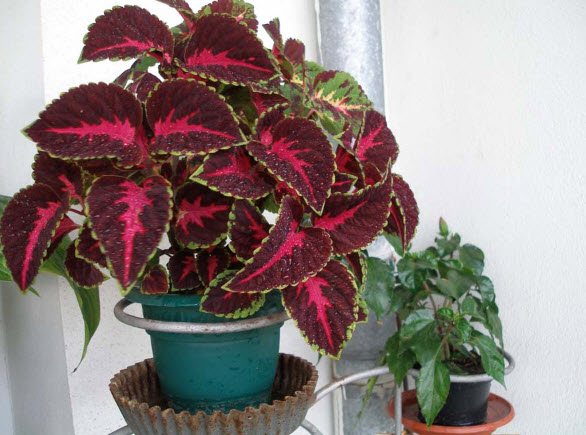

What is the life expectancy?
Coleus houses can grow for several years, but no one keeps them for so long. The flower requires constant rejuvenation. Even with a cardinal "stump" pruning, they should not be kept for more than two years.
Can this plant be kept at home?
Coleus is a plant with good energy. It is ideal for indoor cultivation. The answer to the question: why it is impossible to keep at home is not.
Is this flower poisonous?
Coleus is completely harmless. They will not poison either children or pets, even if they eat it.
Why do Coleus leaves turn yellow (dry)?
This happens for several reasons, described in the "Diseases and Pests" section.
Why do Coleus leaves curl?
The flower is probably infested with parasites.
Why does Coleus shed its leaves?
Leaf shedding can occur due to any defect in grooming.
The most famous species and varieties of plants
The charming flowers of coleus are popularly called the "poor man's croton". They themselves come from hot Africa and the tropical forests of Asia. They are characterized by ribbed stems, lignified at the very base, as well as very attractive cordate, serrated, pubescent leaves that are a bit like nettles. The foliage color of these plants is simply charming, it can combine shades of maroon, green, bright red and even yellow tones. Lilac or blue flowers of Coleus are collected in small spike-shaped inflorescences.However, the cultivation of this plant is carried out exclusively because of the stunning decorative beauty of its leaves.
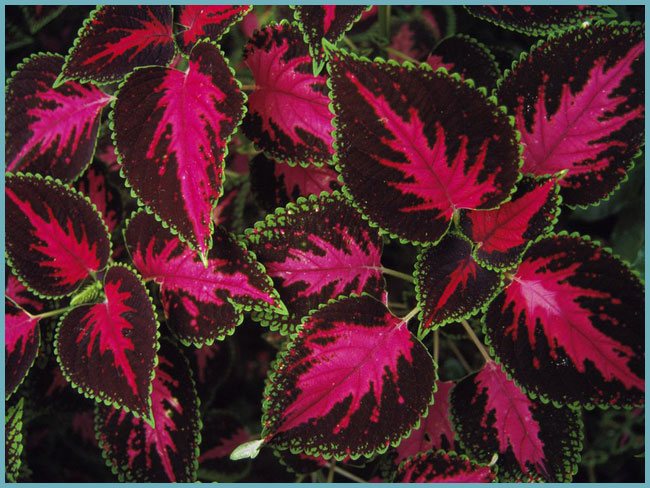

Coleus is very popular for the beauty of its leaves.
Fantastic Coleus, annual and perennial, today has about 150 different species.
For example, polyhybrid varieties and species have earned immense popularity in indoor floriculture. One of their parents was Coleus Blume... The height of the representatives of this species is about 1 m, and its leaves have an oval shape and serrated edges. The shade of the foliage can vary, depending on whether they are in the shade or in the sun.
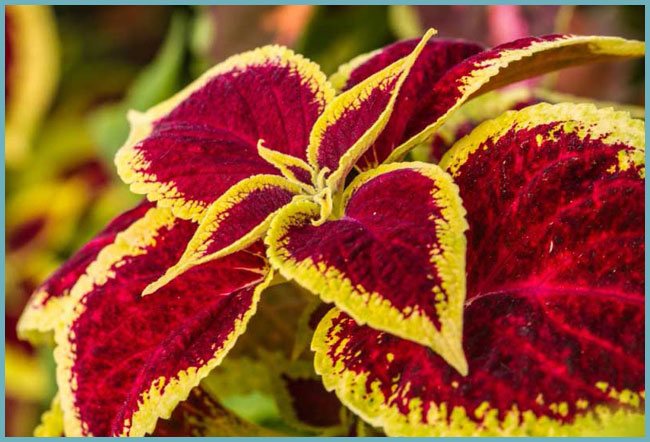

Coleus Blume
Also quite famous Coleus Renelta, which originates from distant Sri Lanka. The leaves of the plant are placed on tall cups, they are opposite, with wavy edges and multi-colored veins.
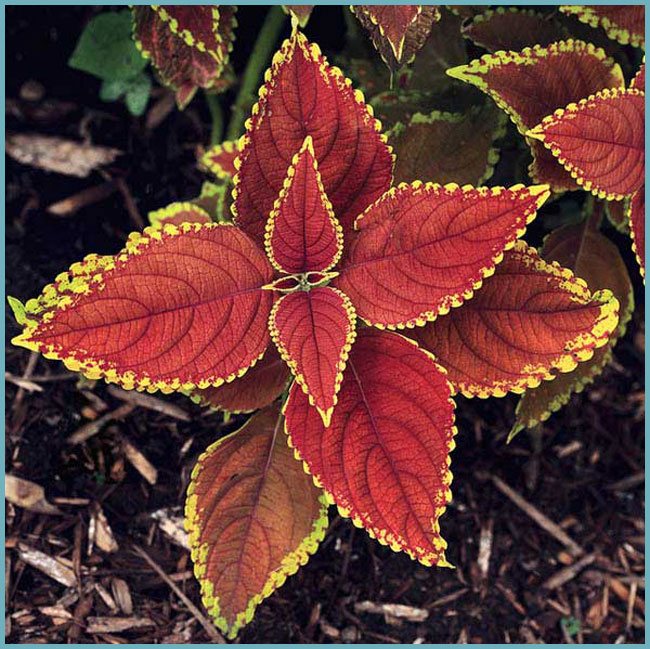

Coleus Renelta
The most popular varieties of Coleus.
- Brilliant. Its representatives are characterized by lemon or red leaves.
- "Butterfly". The foliage of this variety has wavy edges.
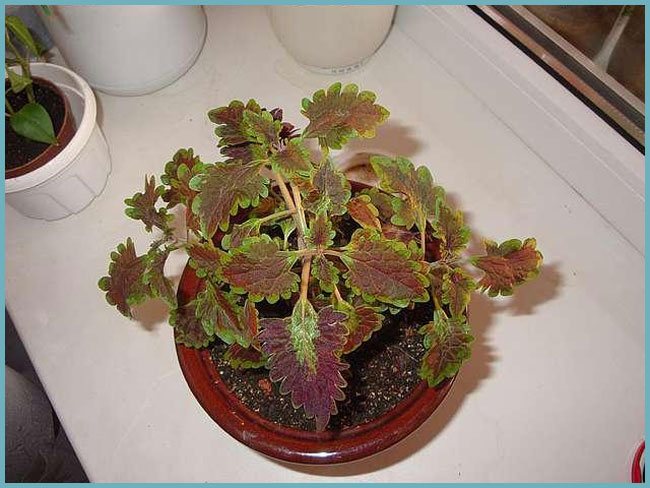

Variety "Butterfly" - Crimson Ruffles. A fairly large variety that has a raspberry-burgundy color.
- Buttercup. These are tall plants with a pleasant white-light green hue.
- "Candidum". The center of the leaf in such coleus is white, and the edge is pale green.
- Golden Bedder. It is characterized by yellow monochromatic leaves.
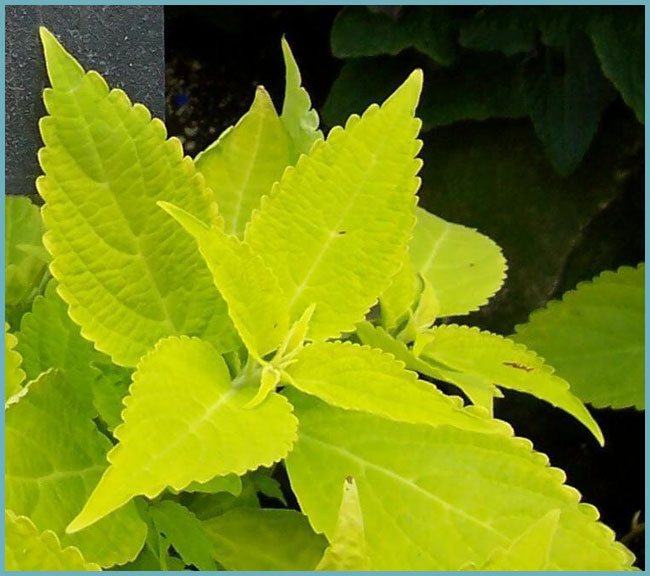

Variety "Golden Bedder" - "Firebird". A very bright and beautiful variety with corrugated foliage.
- "Rose Blush". Lush enough variety. Its large corrugated leaves have a light green edge and a pale pink center.
- "Saber". Compact coleus. Their maximum height is only 20 cm.
- "Salmon Lace". The leaves of these plants have a green-yellow edge and a red center.
- "Glory of Luxembourg". A very attractive variety. Coral streaks are scattered carelessly on its yellow leaves.
How to plant Coleus
Having figured out what a coleus is, and having prepared a place for planting it, you can proceed directly to the process itself. Seedlings of plants are more often planted in open ground, although in some cases summer residents use the seed method.
How to grow coleus from seeds
Coleus reproduces well both by seed and through the use of seedlings, but before planting nettles, it is worth weighing the pros and cons of each of the options. For example, it is no secret that in the first case, the seedlings will have to wait a little longer, while from the seedlings you will quickly get a full-fledged ornamental plant. However, the seed method is much cheaper, since the price of seedlings is often very high.
You will find excellent Dutch and English mixtures on sale, which should be sown at the end of March. Sometimes the sowing of seeds is carried out at other times of the year, but in this case it is likely that additional artificial illumination will have to be organized for the seedlings.
The soil for the plant should be fertile and well warmed up, therefore, to breed Coleus by seed, you will have to use a flat box, evenly spreading the seeds on the surface of the soil. Seedlings are sprayed with a spray bottle and lightly sprinkled with a thin layer of sand.
After that, cover the container with glass and place it in a warm and gloomy place, keeping the ground in a slightly damp state.
Planting Coleus seeds fully justifies itself, therefore, if you are in no hurry and want to save a little, it is better to give preference to this particular method of planting a plant.
Selection and planting of seedlings
Planting Coleus seedlings in open ground is performed after the end of the cold weather, as soon as the ground warms up well. If you yourself grew seedlings on your windowsill, then all that is required is to simply transplant them to a flower bed or garden.
However, if you want to buy ready-made seedlings, then first you need to decide on the variety. The founder of all cultivated species of Coleus is considered to be the Blume variety, which also became the ancestor of the famous hybrids of this plant (the Rainbow series, the Fantasy group, the Dark Chocolate and Black Dragon varieties).
When choosing seedlings of this type, you should pay attention to the color of the leaves (usually they are rich pink with a green frame around the edges), the thickness of the stem and the elasticity of the shoots. Flabby, dried or yellowish leaves on thin legs are best avoided.
Transplanting seedlings into open ground can be carried out from the beginning of June, as soon as the ground warms up and the night frosts recede. To do this, observing a certain distance, dig holes of the desired size in the selected place, add a fertile substrate to them and plant Coleus. After that, all plants are watered moderately.
In general, in terms of care, Coleus can be called an undemanding plant, and when propagated by any of the methods, the growing process will not take a lot of energy from you, especially if you are going to grow it as an annual flower. As for perennials, then for the winter they are dug out of their usual place of growth and stored in pots until spring.
Gallery: coleus (50 photos)
How to choose a Coleus in a store
Before you buy Coleus in a store, decide which of the many varieties you want to buy. When choosing a plant, carefully examine the trunk: there are no rotten or damaged areas that can cause subsequent diseases.
The leaves should also not have dark spots or wet rotting areas, any damage. The leaves should look firm and juicy, with no drying tips or signs of wilting. A healthy and strong plant will tolerate a change of place well and will happily take root in your home.
General description of the plant
Outwardly, it looks very much like a nettle., but its leaves have a velvety surface and are pleasant to the touch. He earned the love of flower growers with a bright and varied color of leaves, which form the basis of its decorative effect.
From other varieties "Black Dragon" is distinguished by a very dark brown-violet color of the leaves, which gives it a certain majesty and mystery.
The shape of the leaves also distinguishes it from fellow varieties. They are oval in shape and have large semicircular teeth at the edges. For more information about what kind of plant Coleus is and what its types are, read our article.
Despite its tropical origin, it does not require the creation of greenhouse conditions and feels quite well both at home and outdoors, even at a temperature of 16 degrees.
What to do after purchase
When buying, simple recommendations are followed, here are some of them:
- A careful examination is required; there should be no traces of diseases or pests on the leaves and stems.
- It is better to make a purchase in the spring, this will help adaptation.
- It is not recommended to purchase blooming coleus. An abrupt change in conditions may adversely affect further growth.
- Take a plant with several shoots, rather than one, with a fluffy crown. These are sure signs of a developed root system.
- Learn about transportation. If it came from abroad, then it needs a transplant, since some types of soil are not intended for long cultivation.
The new Coleus needs adaptation, this process takes about 2 weeks. At this time, it must be protected from drafts, bright sunlight and, if possible, not rearranged.
When transplanting, the native container is left, provided that it is suitable in size. This can be easily identified by the roots, they should not be visible in the drainage holes.
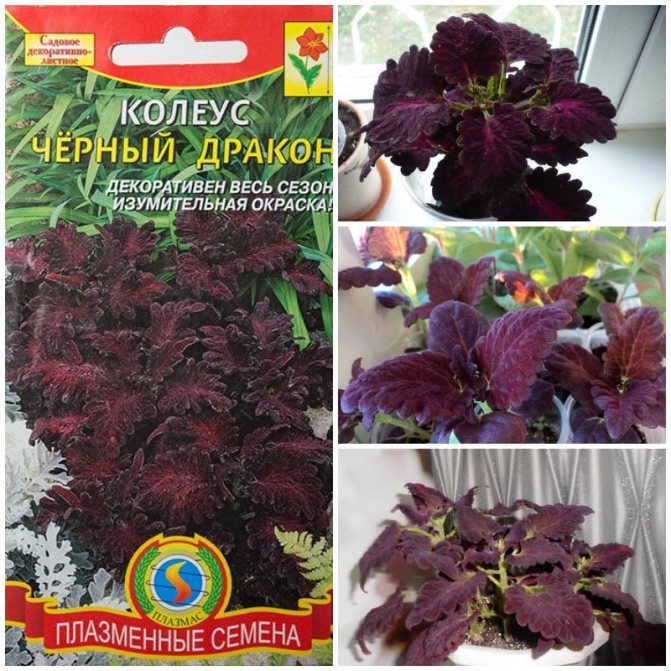

How does Coleus bloom?
The homeland of this flower is the tropical regions of Asia. The coleus plant is popularly called nettle or fiery coleus.In England, they came up with another name for him: "poor man's croton", and all due to the fact that this plant is very colorful and unpretentious. It belongs to the perennial plants of the labiate family. Coleus bushes can grow up to 35 cm in height. Their stems are juicy and almost transparent, and the leaves can be of a wide variety of shades: brown, yellow, green, red, striped or spotted. The plant blooms, throwing out an arrow of small nondescript flowers.
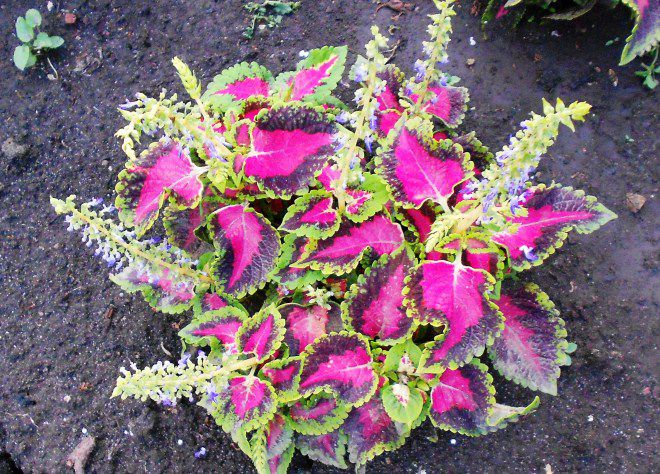

Description
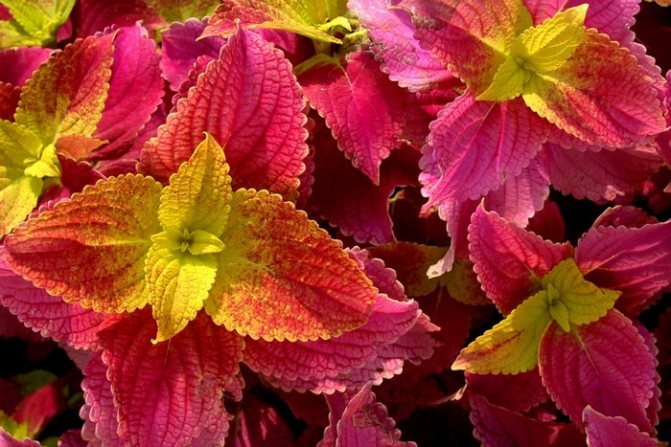

A botanical species native to Java. They were introduced to cultivation in Europe in the middle of the 19th century. Height, 50-80 centimeters high. Flowering period, the inflorescences appear from June during the season along with new increments. Flower color, blue, greenish or white. A place, planted in full sun. Ideally, there will be some shade in the midday hours. Given the height, they tend to bend to the ground, choosing a protected place, they will keep their compact shape throughout the season.
What colors are there
The color palette of Coleus is diverse. The color is monochromatic, two colors and several at once. There is foliage on which there are hundreds of different openwork patterns, color patterns.
What colors and shades of the rainbow are not present on the leaves of the plant. They can be:
- pure white;
- emerald green;
- red;
- burgundy with pale pink veins;
- light green with blue lace;
- bright yellow.
Due to the richness of colors, Coleus have become favorites in decorating garden plots; proudly flaunt on the windowsills.
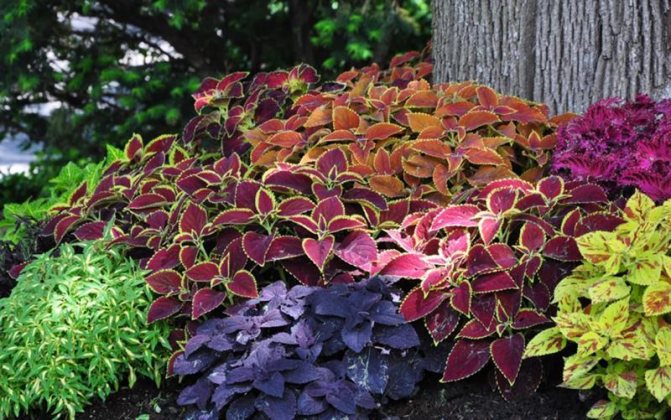

Signs and superstitions that Coleus gave rise to
Why the handsome Coleus "overgrown" with negative signs is not known for certain. Some believe that its bloom brings trouble, someone associates the brightness of its foliage with fire. Others say that "home nettle" will bring poverty to its owner or drive a man out of the house ...
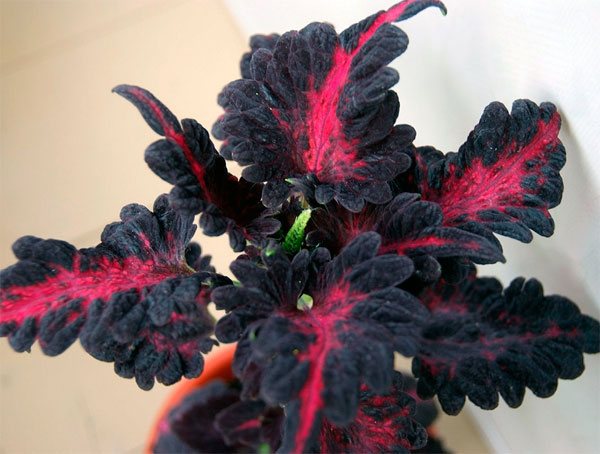

However, many flower growers, communicating with colleagues on specialized forums, say that they are longtime fans and owners of a wide variety of coleus, and over all these years, none of the above troubles have happened to them.
Diseases and pests of Coleus
- Pale color, the appearance of yellow spots are clear signs that the plant is suffering from direct sunlight. Do not delay, try to remove the bush in partial shade or build a canopy, in a few days the individual will recover.
- Old coleuses or those receiving insufficient light are strongly stretched forward. In the first case, you can do very little: slightly increase the feeding and watering, improve the lighting. But the second trouble is easy to fix, change the location of the flower. The same phenomenon is observed in those crops that were not pruned in time. Therefore, cut off the young plant until it is completely formed.
- Falling leaves indicate freezing or overflow. It is worth noting that the same thing happens when there is a shortage of water, so it is worth analyzing the last actions and understanding where you made a mistake. After that, it will be easy for you to eliminate it.
- Poor soil, lacking nutrients, slows down growth significantly. You need to either transplant a flower or buy fertilizers.
- Due to the dry air, the edges of the leaves turn brown, they shrink and lose their shape. Abundant spraying will help.
- Be sure to build a drain so that the liquid does not stagnate. Otherwise, the stem starts to rot.
- Pests are more dangerous for indoor crops, but garden ones are less likely to be negatively affected. Aphids, whitefly and spider mites. They infect an individual, suck out nutrients from it, which causes the Coleus to die. Destroys them with ordinary soap solution, which needs to be treated with the entire ground part of the plant. If all pests have not died, then after a week the procedure must be repeated. But at the same time, you must be extremely careful so that the soap does not get on the soil, otherwise the root system will suffer.For protection, cover the ground with foil, so not a single drop will seep inside.
Coleus is perfect for beginners, hobbyists, or experienced gardeners. This beautiful and bright flower can decorate any home.
When to plant Coleus
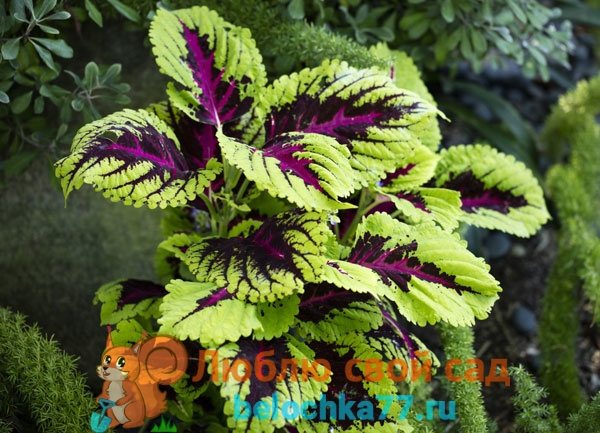

Coleus, as a typical representative of a tropical country, loves warmth and absolutely cannot stand low temperatures. A spring drop in air temperature to + 12 ° C can lead to its death.
In the central zone, in the Urals and in Siberia, it is justified to plant ready-made seedlings on flower beds in late May and early June, you can plant them throughout the summer. Seedlings grown in separate cups take root quickly. Direct sowing of seeds into the soil is permissible only in the southern regions, since they germinate at an air temperature of 20 ° C and above.
Leaving during flowering
Flowering is always an energy-consuming process. And since the flowering of Coleus does not represent any decorative effect, it is necessary to save the plant's reserves of strength for the growth of greenery, rather than harvesting seeds.
The exotic will bloom with long spikelets with small lilac flowers.
From the very beginning of the ejection of a flower spikelet, it should be removed. The cut site does not need processing.
Main and possible problems
Cultivation of coleus does not require much effort and a lot of time, since it belongs to unpretentious plants. But flower growers are faced with such difficulties as:
- Ejection of peduncles, which signals a deficiency in the amount of nitrogen in the soil.
- Hanging foliage. This indicates a lack of humidity or high air temperature.
- Dropping leaves. The reason for this is low temperature indicators and poor-quality watering.
- Fading leaves. If the foliage lost its shine and began to look lifeless, then the plant was attacked by pests (aphids, ticks, whiteflies).
- Pulling the plant, which is observed with insufficient lighting and untimely pruning.
Important! When pests appear, the plant must be treated with special agents intended for indoor flowers.
The luxurious black dragon, a photo that mesmerizes and impresses with its unusual appearance, is a popular houseplant. Caring for it is simple, in exchange for care and attention, Coleus will add sophistication to the interior and create warmth and comfort in the room.
In conclusion, we suggest you see how you can decorate your garden or cottage with coleus:
The healing magic of the plant
Coleus dragon black is considered not only a home decoration, but also a natural healer of particular interest to people who are learning to do without pharmaceuticals, replacing them with natural medicines and a healthy lifestyle.
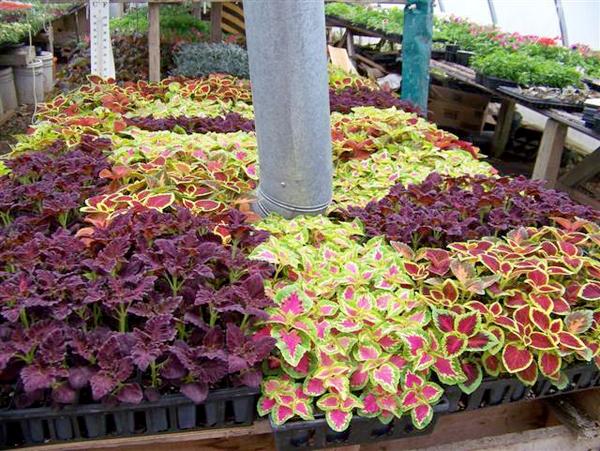

The benefits of a plant are determined by its chemical composition, of which forskolin is of particular value. Therefore, Coleus is complex strengthens and restores body functions, stabilizes the operation of important systems. When applied, health improvements and rapid recovery are monitored because it:
- has a positive effect on metabolism;
- helps to better absorb vitamins and minerals;
- lowers blood pressure indicators;
- normalizes the digestive system;
- burns fat cells in the body.
To benefit from the healing properties of coleus, you need to take its root part, wash it thoroughly, dry it and grind it. Put the finished product in a glass jar and use it dry as a food additive as needed.
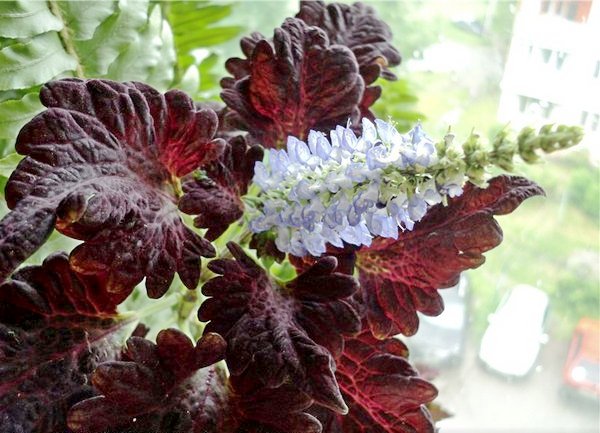

The advantages of the seedling method
Cutting, like the seedling method of growing a plant, takes a lot of time and is associated with some difficulties. If you choose from these two known options, then planting with seeds is more profitable. All the more difficult is the process.
The positive aspects of the seedling method are:
- simplicity of the process, uncomplicated care of the seed;
- you can decide on a permanent place for planting seedlings;
- due to the preparatory measures, the plant's immunity is strengthened;
- the ability to resist infections increases;
- fertilizers are selected independently. Therefore, adherents of folk remedies and organics are at hand;
- it is not required to carry out manipulations that can kill coleus, namely, to infect.
If you decide to try grafting, then there is no guarantee that after cutting off the top, the adult plant and the cut part will fully develop.
Mister Summer Resident recommends: Coleus Black Dragon - a natural healer
Coleus, in addition to its decorative function, also benefits as a natural remedy. This is due to the chemical composition of the plant and the forskolin included in it.


At home, use the root part of the coleus, which is thoroughly washed, dried and ground into powder. After cooking, pour it into a container and add it to food. As a dietary supplement has a positive effect on all body systems:
- Affects the thyroid gland and participates in the burning of fat cells.
- Reduces blood pressure.
- Helps the absorption of vitamins and minerals.
- Helps improve digestion.
- Has a tonic effect.
The amazing variety of Coleus Black Dragon has an unusual color of leaves that will look original both on a garden bed and as a window sill decoration. In addition, substances useful for the body will not leave indifferent any lover of traditional medicine.
Various hybrid varieties
Suitable for growing in the home or garden.
Read also How to grow Indian onions at home
Perhaps, if you bring together several varieties and varieties of Coleus, it will be difficult to imagine that this is one and the same plant. Its height varies from 20 cm to 1 m, the color of the leaves is from pale beige to purple, almost black shades. Yes, Coleus is grown mainly not because of the beauty of the inflorescences, but because of the noble "appearance" of velvety leaves.
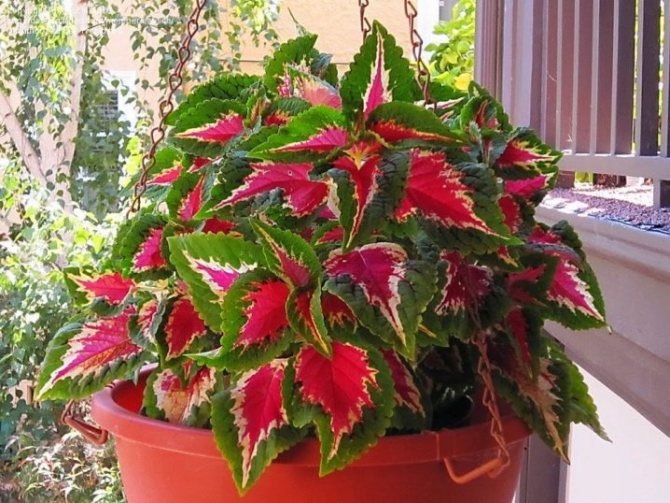

Features of the
Coleus are plants in the form of small bushes. Its distinctive feature is lush and numerous leaves, similar in appearance to nettles. However, Coleus boasts a variety of shades of these leaves. By the way, because of the similarity, Coleus is often called "nettles" among the people.
Another name - "poor man's croton", as if hinting at the fact that the beauty and luxury of the leaves of the plant can compete with the more noble - codiaum.
Coleus is grown both as an annual and as a perennial. Despite the fact that the tropics are considered its homeland, domestic flower growers and gardeners note the unpretentiousness of the plant, the ease of caring for it. In the wild, the plant reaches 50-100 cm in height. And, although it blooms, the leaves are still considered the main decoration of the nettles. His inflorescences are small and inconspicuous.
The plant has a light-loving disposition. With a lack of light, it changes the bright color of its leaves to faded. This can be observed in winter. However, the bright color of the leaves at the same time allows the plant to protect itself from UV rays. However, despite such persistence, it is better to shade a tropical guest in the hot summer heat.
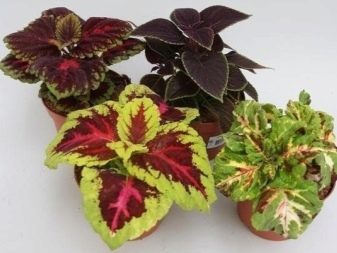

The optimum temperature for nettles is + 20… +25 degrees. At the same time, she is not afraid of minor temperature changes. The critical threshold for lowering the temperature is +12 degrees, the plant can die even with spring frosts. That is why the plant is planted in open ground at the end of May, when the earth and air are warmed up to 15-17 degrees.
In hot weather, Coleus requires moisture as the earthen coma dries. At the same time, the plant will tolerate a short-term drought more easily than excessive watering. Although, ideally, the earthen ball should always be slightly damp. In the summer heat, you can spray the air around the Coleus with water, avoiding moisture on the leaves.The latter should not be wiped with a damp cloth, as this can easily damage them.
Drip irrigation should be avoided. Before watering and after prolonged rains, it is recommended to loosen the soil... The plant is propagated by seeds or stem cuttings. Experienced gardeners usually resort to seed propagation, while the second method will be quite simple and understandable for everyone.
Born in the rainforests, Coleus, whose photo is presented below, fell in love with the European growers with saturated color of leaves. The decorativeness of the plant and the simplicity of the conditions of detention made it a desirable decoration in landscape design and in the interior of an apartment.


The rich color of the foliage combines green and various shades of red, sometimes with the addition of white blotches. The height of the shrub is from 30 to 80 cm. Juicy stalk of Coleus in cross section has a rectangular shape.
Serrated leaves are placed in pairs at each node, opposite each other. They look like nettle foliage, that's why coleus is called "nettle"... The blue flowers have a pleasant aroma and are collected in a spike-shaped inflorescence.
Note to the florist
- The main "highlight" of the Coleus is the variegated coloring of its leaves. In order for an indoor flower to show itself in all its glory, in neighbors it is worth choosing plants with a monochromatic color of leaves for it.
- In the cold season, Coleus is best kept on the windowsill in the kitchen.
- Young Coleus acquires a "presentable" appearance 5 months after planting - knowing this, you can easily determine the planting time for yourself.
- The warmer it is in the room where the coleus grows, the more abundant it should be watered.
- If the flower is forgotten to water and its leaves have lost their elasticity, the soil in the pot must be generously moistened and the flower must be sprayed with water from a spray bottle. Coleus will soon come to life.

